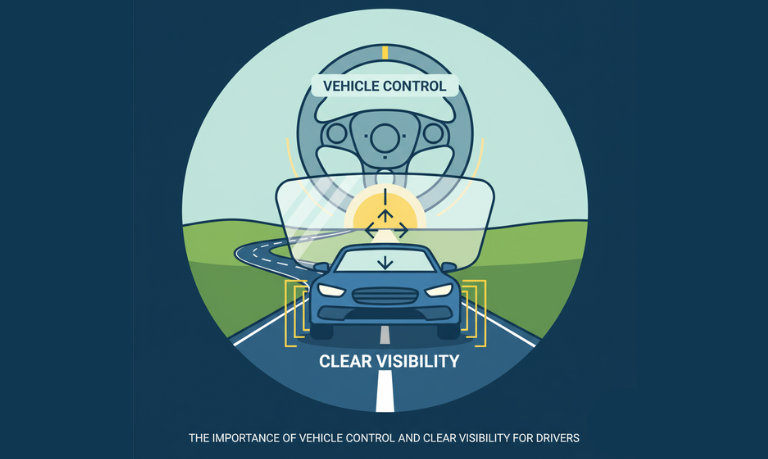The Importance of Vehicle Control and Clear Visibility for Drivers

Ever driven a car at night or in fog? You can’t see the road clearly, and you’re not sure of the speed or distance to maintain. It’s not just frustrating but also scary and risky! While foggy weather is a special condition that you won’t face all the time in NSW, visibility and vehicle control are essential at all times for drivers. Maintaining full control of your vehicle and having a clear view of the road ahead are two fundamental aspects of safe driving. They’re also the first things newly licensed drivers take for granted once they become comfortable behind the wheel. Whether you’re an experienced driver or still taking driving lessons with a Sydney driving school, understanding how control and visibility affect your safety can make a life-changing difference on the road.
Staying in Control: The Foundation of Safe Driving
If you think operating a vehicle is all about handling the steering wheel, you’ve got another thing coming! Beyond steering, you must also be physically and mentally prepared to respond to sudden changes in traffic, road conditions, or weather. And this is where vehicle control matters. Staying focused, having quick reaction times, and habitual movements are essential for a driver to have good vehicle control. Good control also means proper seating, both hands on the wheel, proper positioning, and good coordination. Smooth acceleration and keeping your feet always ready to brake are also signs of a driver well in control.
Other aspects of control while driving include smooth and proper merging, overtaking, parking, and lane changes. Many Sydney driving school teach new drivers to stay centred within their lane, maintain safe following distances, and adjust their speed according to traffic flow. It’s these small habits that improve control and make the biggest difference when quick decisions are needed.
The Importance of a Clear View
Are you wondering why visibility is necessary for driving? It should be clear enough already! You can’t avoid what you can’t see. Clear visibility allows you to anticipate hazards, read signs, and spot pedestrians or cyclists early enough to react safely.
So, how can you get full visibility on the road? Here’s what contributes to good visibility:
- Clean Windows and Mirrors: Dirt, fog, or glare can distort your view. Keep your windscreen and mirrors spotless — inside and out.
- Proper Mirror Adjustment: Adjust your rear-view and side mirrors to cover as much of the surrounding area as possible without overlapping.
- Good Lighting: Ensure your headlights, brake lights, and indicators are clean and working properly, especially during early mornings or rainy days.
- Seating Position: Sit high and upright, ensuring you can see over the dashboard comfortably. Your seat should be close enough to reach the pedals without stretching but far enough to avoid fatigue.
Whether you’re a seasoned driver or still taking driving lessons, visibility is non-negotiable. Even the best drivers can struggle if their view is compromised. Foggy windows, clutter on the dashboard, or even hanging decorations can create blind spots or distractions, which can be dangerous.
Why It Matters
You’d think losing control or having your view blocked for a few seconds isn’t that big an issue. But the fact is that even a momentary loss of control can become risky or even fatal at any time while driving. In fact, low visibility and loss of focus are among the top causes of avoidable accidents each year.
As a driver, if you cannot see clearly or have full control of the vehicle, you won’t be able to react properly or on time to any hazard on the road. You may fail to spot a pedestrian crossing, or a vehicle merging lanes, or a sudden obstacle on the road in time to respond. That’s why maintaining both clear vision and full control is essential not only for your own safety but for everyone sharing the road with you.
Most Sydney driving schools and instructors often emphasise that awareness and control go hand-in-hand while driving. You can join a Safer Drivers Course to learn how to stay calm, alert, prepared and in charge while driving, even when something unexpected or unprecedented happens.
See also: Nurturing Talent Through Creative Arts Education
Simple Habits for Safer Driving
Here are a few simple yet effective habits to keep yourself in full control and ensure clear visibility:
- Adjust Before You Drive: Properly position your seat height, mirrors, and steering wheel before starting any journey. Making these adjustments before the journey ensures you have better control and visibility on the road.
- Keep Your Windows Clean: Regularly wipe down interior and exterior glass to prevent glare. This helps increase visibility and prevent unnecessary risks.
- Check Your Mirrors Every Few Seconds: Keep checking mirrors regularly to stay aware of vehicles behind and beside you. If you know who’s where and doing what on the road, you’ll be better prepared in case something happens suddenly.
- Avoid Clutter: Don’t hang large objects or stickers that obstruct your view. Low visibility can be very risky and can even lead to fatal accidents.
- Stay Focused: Avoid multitasking or looking at your phone. Every distraction reduces control and increases the chances of accidents.
- Adapt to Weather: Slow down and increase following distances when visibility drops in rain, fog, or glare. Learn how to handle your vehicle and increase visibility in different weather conditions by joining a Safer Drivers Course from a trusted driving school.
Final Thoughts
Whether you’re an experienced driver or a beginner taking your first driving lesson with a Sydney driving school, you should remember that control and visibility are the foundation of road safety. The more clearly you can see and the more confidently you can respond, the safer everyone around you will be.
Driving is a skill that demands constant attention and care. By staying alert, maintaining your vehicle, and practising good habits, you’re not just following the rules — you’re helping to make Australian roads safer for everyone.





